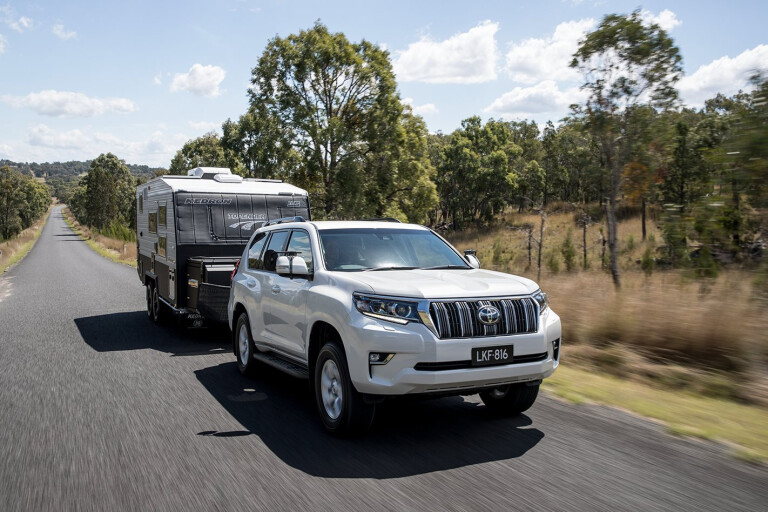
Score breakdown
Things we like
- Tough and comfortable family wagon that can go anywhere
Not so much
- Lacklustre diesel performance
What stands out?
The big-selling Toyota LandCruiser Prado is a large SUV-type wagon with a seven-seat cabin, proven reliability, and peerless service back-up. For a big 4WD vehicle it is very comfortable as a day-to-day family car, but it is also built extra tough and is one of the best choices for long outback trips.
All Prado versions are equipped with a six-speed automatic gearbox and autonomous emergency braking
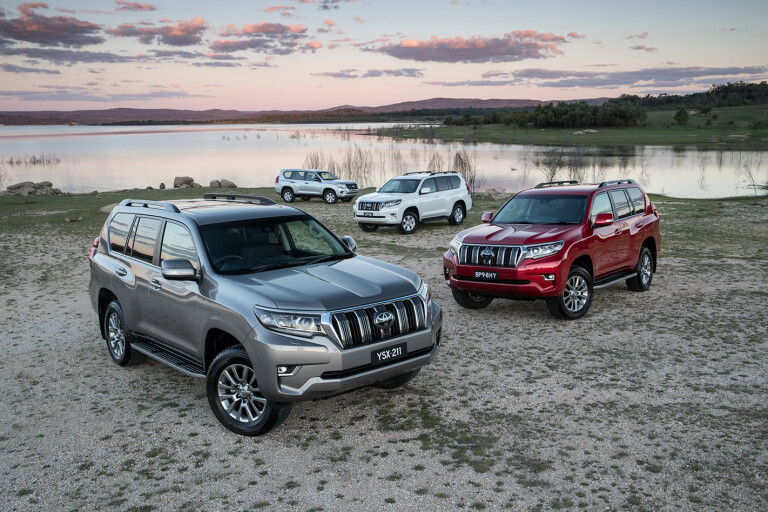
What might bug me?
Modest overtaking performance. The 2.8-litre turbo diesel engine, first introduced in September 2015, is not significantly quicker than its predecessor.
This engine received a power boost in October 2020 for the MY21 model, so we will be keen to see how much of an improvement there is once we get to test it.
That some other big wagons can legally tow more. The Prado is rated to tow up to 1000kg less than the Jeep Grand Cherokee and Land Rover Discovery. (Which means you can’t match their ability to tow another big 4WD vehicle on a car trailer, for example.)
What body styles are there?
Five-door wagon only. All but one version has seven seats. The exception is the least costly, the GX, which offers a five-seat option.
All Prados have dual-range, full-time four-wheel drive. The Prado is classified as a large SUV, lower priced.
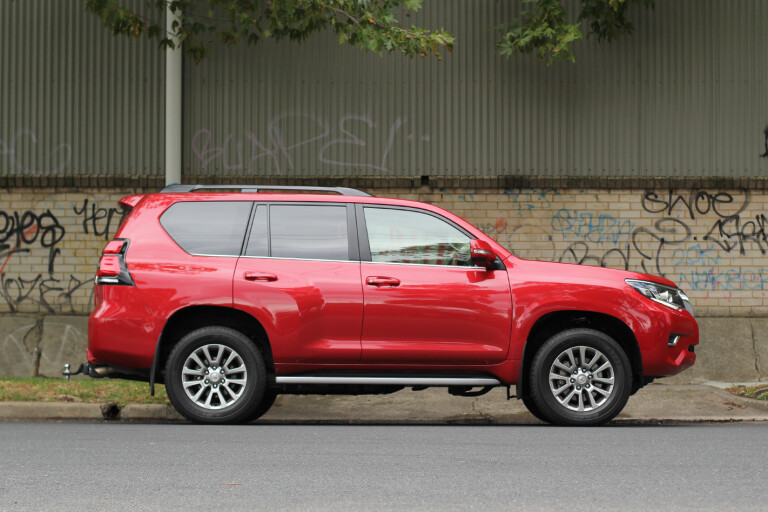
What features do all Prados have?
- A 9.0-inch touchscreen, with Apple CarPlay/Android Auto smartphone pairing and MyToyota which adds third-party apps such as Waze, AccuWeather and Stitcher.
- A rear-view camera, satellite navigation, cruise control, air-conditioning, Bluetooth phone connectivity, tilt and reach steering wheel adjustment, audio and phone controls on the steering wheel, and a USB port.
- Toyota's Pre Crash Safety System, which incorporates autonomous emergency braking with pedestrian and cyclist detection.
- A six-speed automatic gearbox - the six-speed manual versions were deleted from the range from October 2020 for the 2021 model year.
- On all models, the doors can be opened as long as you have the key in your pocket or bag. To start the engine, you push a button. Toyota calls this Smart Entry and Smart Start.
- Rain-sensing windscreen wipers.
- Aluminium alloy wheels and a full-size spare.
- Cooler box.
- Floor mats.
- Heated power-folding door mirrors.
- Cargo blind.
- Electronic stability control, which helps the driver control the vehicle in a skid. This is mandatory on all new cars.
- Electronic traction control, which helps prevent wheel spin in slippery conditions and is a great help off-road.
- Trailer sway control.
- Downhill and Hill-start assist control.
- Polished aluminium-alloy wheels, which are generally lighter and look fancier than steel wheels.
- Seven airbags. Anti-lock brakes, and electronic stability control – which helps you control the vehicle in a skid. (For the placement of airbags, and more on Prado safety features, please open the Safety section below.)
- All Prados come with a five-year, unlimited-kilometre warranty.
Which engine uses least fuel, and why wouldn't I choose it?
The 2.8-litre turbo-diesel is now the only engine option, with the more powerful, but thirstier, V6 petrol deleted from the range in November 2017 due to a lack of customer demand.
It received a power boost in October 2020 for the 2021 model year. In the official test (printed on the windscreen sticker) the updated engine uses 7.9 litres/100km with the six-speed automatic gearbox. In real-world driving expect to use about 10 litres/100km.
It is designed for touring but is known for lacking a little power for everyday driving and doesn’t overtake strongly. We look forward to seeing how the power increase improves performance.
The six-speed manual that available in the least costly GX, and GXL was dropped from the range from October 2020. With the manual gearbox, 2017-2020 Prados had an official combined fuel consumption of 7.9 litres/100km.
(Power outputs and all other Toyota Prado specifications are available from the Cars Covered menu, under the main image on this page.)
What key features do I get if I spend more?
The entry-level Prado GX, comes with 17-inch alloy wheels, rubber floor mats, manual air-conditioning and a cool-box in the centre console that uses the air-conditioner to chill food.
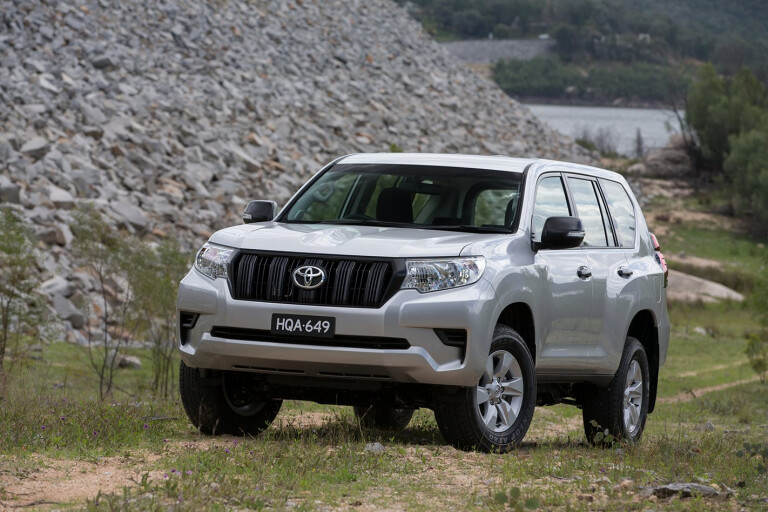
It also comes standard with five seats, but you pay about $2550 for a third row of seats, and extended curtain airbags for their occupants, as options.
Upgrading from the GX to Prado GXL also brings seven seats as standard along with:
- Side steps, which make it easier to get in and out of the car.
- Roof rails for mounting luggage systems.
- Long-lasting LED headlights, LED daytime running lights and LED front fog lamps
- Rear parking sensors.
- Three-zone climate control air-conditioning, which lets the driver, front passenger and rear-seat passengers separately set their desired cabin temperatures.
- A driver-switched lock for the rear differential, which can help you go further in difficult 4WD conditions.
Prado GXL variants can also be specified with a premium leather-accented interior as a $3,470 option.
All versions from the GXL up come with a no-cost option of having the spare wheel and tyre stowed underneath the Prado rather than on the tailgate.
Spending more on the Prado VX brings:

- Bigger 18-inch alloy wheels.
- Leather-trimmed seats.
- Heated and ventilated front seats with lumbar support.
- Third-row seats that retract with the flick of a switch.
- Refrigerated centre-console cool box.
- 14-speaker JBL premium sound system.
- Headlights that switch on automatically when it gets dark.
- Blind-spot warning and a rear cross-traffic alert.
- Front and rear parking sensors.
- Multi-terrain monitor that uses front, rear and two side cameras to allow the driver to check vehicle blind spots and confirm their surroundings. This includes a panoramic view that enables the driver to check for other vehicles at blind intersections.
Spend more for the Prado Kakadu and your best additional feature will be its Kinetic Dynamic Suspension System, which gives both flatter on-road handing and more off-road capability. KDSS works by automatically adjusting the tension on the suspension’s anti-roll bars. For some reason, this feature was removed from the VX in November 2017.
The Kakadu also features Crawl Control, which automatically controls the accelerator and brakes through very rough terrain at a speed you select: all you have to do is steer.
Multi-Terrain Select allows you to tailor stability control and traction control for different off-road conditions. The Kakadu also has self-levelling and height-adjustable rear suspension, and the driver can change suspension settings for a softer ride, or sportier handling.

On the luxury side, the Kakadu has a sunroof and driver’s seat that remembers settings for two different drivers. And a rear-seat DVD entertainment system can help keep children occupied.
Does any upgrade have a down side?
Although many people will like the look of the VX and Kakadu’s 18-inch wheels and their accompanying lower-profile tyres, they don’t ride as comfortably as the standard 17s and are more damage prone and less effective off-road.
Glacier White and Ebony (black) are the only two standard colours. All the rest are extra-cost options.
How comfortable is the Prado?
The Toyota Prado is roomy, well finished and very user-friendly. All the switches and knobs are large and easy to identify, while the major controls are light and easy to use. The only challenging aspect is the complexity and sheer number of switches on the top-spec Kakadu model.
Otherwise, this is a very easy car to operate and drive.
At the time it went on sale the 2021 Prado was at the time the latest Toyota to receive Apple CarPlay/Android Auto as part of its infotainment package. It also has the MyToyota which adds third-party apps such as Waze, AccuWeather and Stitcher via the 9.0-inch touchscreen.
Seats in the Prado are supportive and comfortable, and nice places to be for even the longest trip. Compliant, soft-riding suspension and low road-noise levels on all surfaces, even gravel roads, make this a car that can eat the kilometres without fatiguing the driver or passengers.
The 2.8-litre diesel engine is also very quiet and smooth by diesel standards, and hardly sounds or feels like a diesel engine at all.
What about safety in a Toyota Prado?
All 2021 Prados feature Toyota's Pre Crash Safety System, which incorporates autonomous emergency braking. If it concludes that a collision with another vehicle, cyclist or pedestrian may be imminent, it triggers an audio-visual warning, pre-tensions the front seatbelts, and if necessary adds brake pressure. If you don’t press the brake pedal, the system will brake for you
The VX and Kakadu also warn you of vehicles lurking near your rear corners that might not appear in your mirrors. A rear cross-traffic alert warns you of approaching cars when you are backing out of a parking spot.
All Prados have anti-lock brakes, stability control, seven airbags, and a reversing camera.
There are two airbags directly in front of the driver and passenger; an airbag for the driver’s knees; chest-protecting side airbags immediately outside the driver and passenger; and curtain airbags extending down each side of the car that protect at head level.
Where third-row seats are fitted, the curtain airbags protect those rearmost passengers also.
The Prado GXL, VX and Kakadu also have rear parking sensors. When reversing, these may alert you to the presence of hazards behind that you have not noticed in your mirrors or rear-view camera.
The Australasian New Car Assessment Program (ANCAP) has awarded all Prados its maximum five stars for safety. The five-star rating was re-issued in August 2015.
I like driving - will I enjoy this car?
The Prado is not for drivers who like a car with responsive steering and nimble handling. It’s too high-riding and heavy for that, and the soft, long-travel suspension only adds to the body roll – which passengers won’t like, even if the driver doesn’t mind.
The Kakadu’s KDSS suspension is much better in this regard as the body roll is reduced.
The Prado is not for people who like lots of acceleration. The 6th ratio added to the automatic gearbox doesn’t help, as it’s merely an additional and taller overdrive.
What everyone will enjoy about the Prado is its comfort and quietness on even the worst roads.
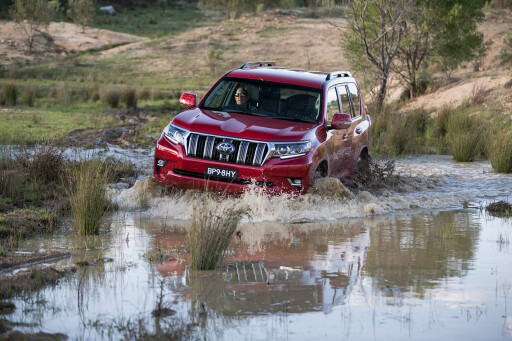
The Prado is also very capable in genuine off-road conditions. Among the big family 4WD wagons, only the Ford Everest, Land Rover Discovery and the Prado’s Fortuner and LandCruiser 200 stablemates can match or better it here.
How is life in the rear seats?
The Prado is a big car and that is reflected in a spacious rear seat that can adjust fore and aft, for either more legroom or more luggage space. However, it’s still tight across the shoulders for three adults.
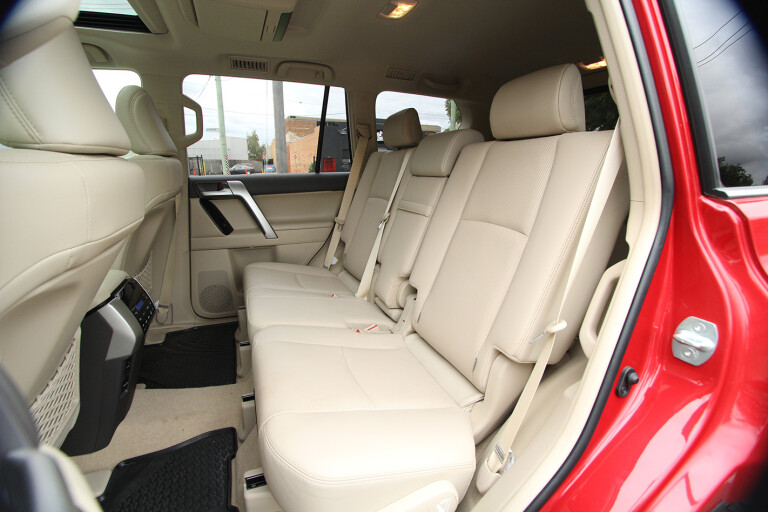
Given the Prado’s height and big doors, getting in and out of the rear seat is a breeze.
Likewise, access to the third-row seats is good. As is often the case, the third-row seats are suitable only for children or smaller adults.
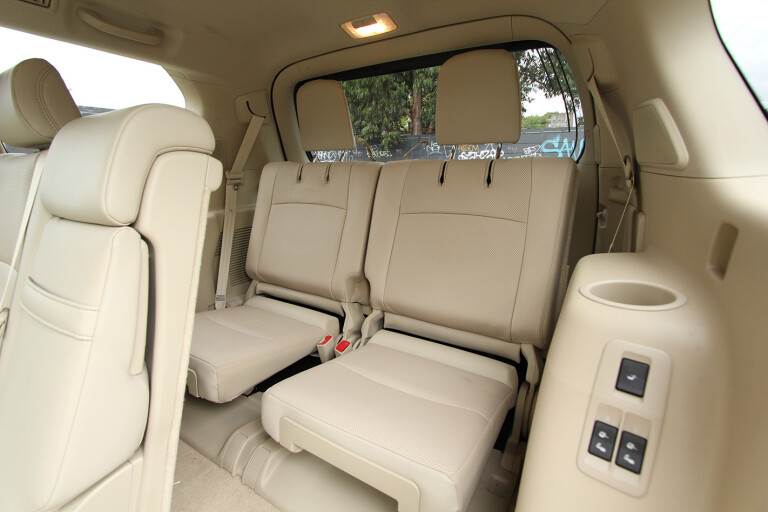
All models have air-conditioning vents for rear-seat passengers.
How is it for carrying stuff?
The Prado has a big luggage area, but third-row seats that fold down into the floor do eat into the overall cargo volume.
With five seats use the boot space holds 620 litres of stuff, but with the third row in play that's reduced to 120 litres. Folding down the third and second rows increases capacity to a very handy 1833 litres.
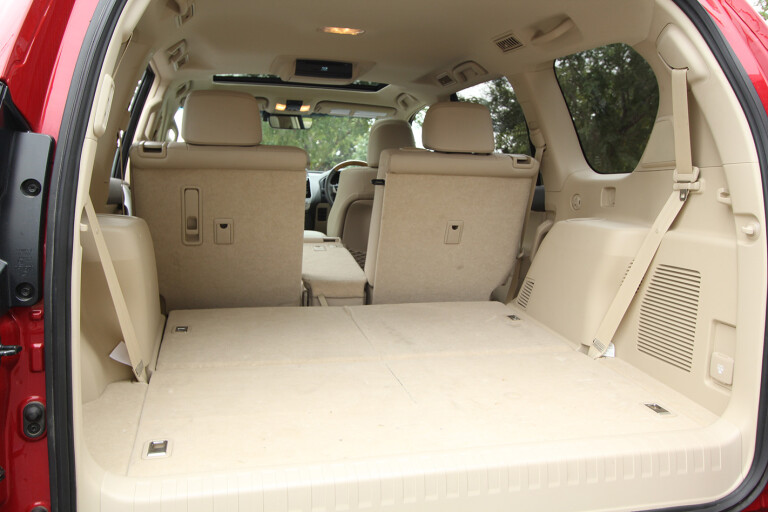
The single rear door opens sideways and can be heavy to handle when the vehicle is on a slope.
The GXL, VX and Kakadu versions with the optional under-body mounted spare tyre model is more convenient here, as the rear door is lighter and the rear-glass opens separately.
The Prado’s towing capacity of 3000kg (braked trailer) is sufficient for most long-distance towing needs.
Where does Toyota make the Prado?
All Prado models sold in Australia are made in Japan.
What might I miss that similar cars have?
More power from a diesel engine, for swifter overtaking and easier towing. Toyota’s own LandCruiser 200 offers a much bigger V8 turbo-diesel, for example. The Land Rover Discovery and Jeep Grand Cherokee offer diesel engines with more power than the Prado’s, and eight-speed auto gearboxes.
The Discovery and Grand Cherokee also offer sportier on-road handling. (The Grand Cherokee is not as comfortable off road, however.)
Among other vehicles you might consider are the seven-seat 4WD wagons developed from utes, among them the Ford Everest, Toyota Fortuner, and Mitsubishi Pajero Sport.
Alternatively, if you want seven seats and all-wheel drive but do not intend to stray far beyond good gravel roads, you might consider more car-like alternatives such as the Toyota Kluger, Mazda CX-9, Nissan Pathfinder, Hyundai Santa Fe, and Kia Sorento.
RESEARCH: WhichCar SUV Buyers Guide
I like this car, but I can't choose which version. Can you help?
Unless you must have a manual, go for the automatic for the active safety and increased towing capacity.
The GXL spec has everything most people want, and even if you don’t need the third-row seats they will help with resale value. And you can get a leather interior for $3500 without having to upgrade to the VX, which has some good extras, but with a big price hike.
The GXL is the most popular variant by a good margin, and for good reason.
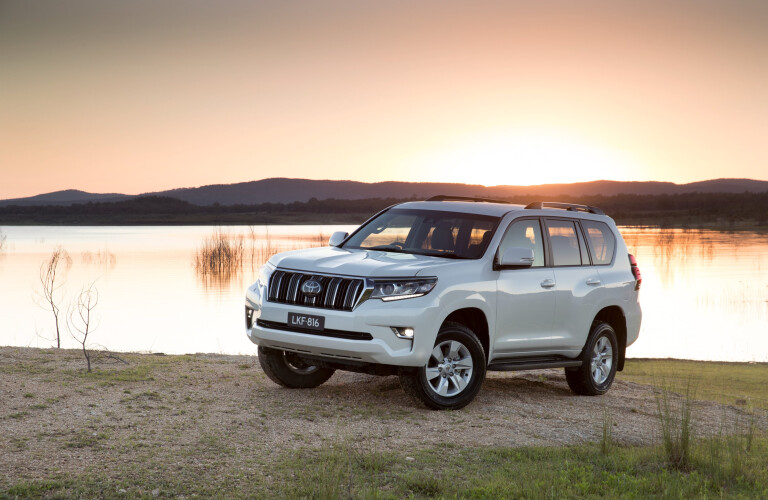
Are there plans to update the Prado soon?
The 150 Series Toyota Prado was released in late 2009 and updated in November 2013 with new exterior styling, a new dash and some additional features.
In September 2015 it gained an all-new, 2.8-litre diesel engine and an automatic gearbox with six ratios, replacing the previous 3.0-litre diesel and five-speed automatic.

About that time Toyota dropped the special-edition Prado Altitude variant, on which the spare tyre was relocated under the car. The Altitude returned, with the new engine, in April 2017.
The Prado received a long-overdue facelift in November 2017 for the 2018 model year, which brought a reshaped bonnet and headlights, and a redesigned dashboard and instruments. The V6 petrol versions were axed and the GX and GXL automatics gained the Pre Crash Safety System, which was previously only available in the VX and Kakadu.
In August 2018 Toyota added a no-cost option of having the spare wheel and tyre stowed underneath the Prado GXL, VX and Sahara variants rather than on the tailgate, which proved popular with the limited edition Altitude versions.

In March 2020 it introduced a Prado Kakadu Horizon special edition featuring a number of exterior styling enhancements including a front bumper spoiler, chrome side moulding, illuminated front scuff plates and clear rear combination lights.
In October 2020 Toyota dropped the manual versions from the range and added 9.0-inch infotainment screen with Apple-CarPlay and Android Auto. It also increased power to the 2.8-litre turbodiesel engine and added pedestrian and cyclist detection to the AEB system.
It is unclear when the Prado will be next updated or replaced.
Score breakdown
Things we like
- Tough and comfortable family wagon that can go anywhere
Not so much
- Lacklustre diesel performance

COMMENTS